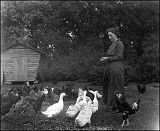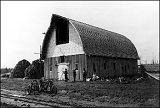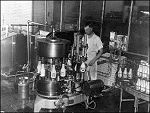The early farmers in southern Minnesota raised corn, hay and small grains and kept a variety of animals in barns and barnyards. Wheat was the mainstay of north-western Minnesota farming. The success of the giant flour mills in Minneapolis and the building of railroads to the northwest supported wheat production in the Red River Valley. Throughout the first half of the twentieth century, corn was grown in a three-year rotation with hay and a small grain, like oats or barley. Oats lost much of its market when tractors replaced horses and mules as the primary power means for field machinery.
As tractors replaced horses and rural electrical services moved out into the countryside, farmers planted more specialized crops, dairy cattle produced milk products on a year-round basis, and a car or truck in the garage provided mobility - unheard of in earlier times. With advancing technology, the size of farms increased and the number of farmers decreased, as many chose to become a part of the technological revolution and the urbanization of Minnesota. [MIACOC] |
|
|
Farmers and Farm Families

Mrs. Stone feeding chickens and ducks.
Photo by Louis Enstrom
Minnesota Historical Society

New barn constructed on Beltrami Island.
Part of relocation project by F.S.A. borrower
with technical assistance by
F.S.A. engineer. Total cost of material & labor
on barn was less than $400.00. ca. 1937
Photo by Vachon
Farm Security Administration and Minnesota Historical Society

Bottling milk at the Duluth Milk Company, Duluth, Minnesota
Photo by Vachon for F.S.A., Aug. 1941
Minnesota Historical Society
|





